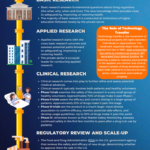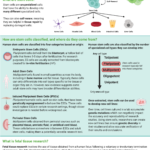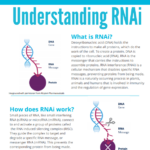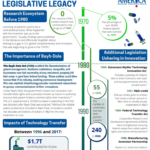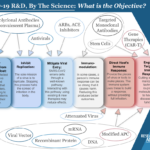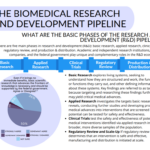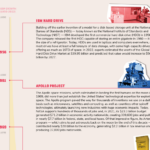Fact Sheets And Graphics
Research!America has developed several series of brief reports to highlight the benefits of research to improve health.
To illustrate the social and economic impact of medical and health research, we established the Investment in Research Saves Lives and Money series in partnership with the Lasker Foundation. Each page focuses on one or a set of conditions or health topics and includes current statistics, examples of cost- and life-saving benefits of research and the story of a patient who has thrived or survived thanks to research.
Agency Fact Sheets
Various federal agencies are integral to R&D in the U.S. To learn more about each agency’s contributions, public-private partnerships, recent progress and the public’s opinion, see our fact sheets below.
Infographics
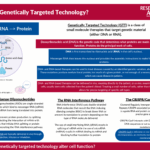
What is Genetically Targeted Technology?
Genetically Targeted Technology (GTT) is a class of small molecule therapies that target genetic material (either DNA or RNA) to address diseases caused by genetic variations. GTTs are being developed to treat a range of conditions, including rare diseases, and are expected to play a key role in the development of new treatments in the future. To learn more about this technology, download this infographic.
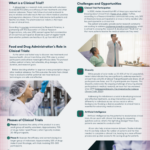
The Basics: Clinical Trials
Clinical trials are research studies conducted with volunteers to evaluate the safety and efficacy of new treatments and other medical advances. These trials follow structured protocols to ensure reliable and valid results that can inform medical practice and regulatory decisions. According to a survey commissioned by Research!America, in partnership with the Association of Clinical Research Organizations (ACRO), sixty-one (61%) percent agree that consideration of clinical trial participation should be a part of regular health care whether patients are healthy or ill, up from 44% in 2017. To learn more about clinical trials, download this infographic.
The Research & Development Pipeline
The research & development pipeline is a process that produces meaningful progress against deadly and debilitating health threats. Patients; federal, state, and local governments; industries spanning pharmaceutical, medical technology, manufacturing, health care, and more, each play a role in combating threats that needlessly rob each of us of health, capacity, and time. To learn more about his process, download this infographic. You may also want to look at our primer on the pharmaceutical research and development pipeline and watch the video of our Capitol Hill briefing on “Discovery, Development, Delivery: Understanding the Biomedical Research and Development Pipeline.”
The Science of Stem Cells
Research involving stem cells is an integral part of the U.S. biomedical research landscape, aiding the development of life-saving therapeutics, improving our understanding of human development and countless diseases, and establishing a new platform for revolutionary cell therapies. But what are stem cells and how do they work? How do stem cells differ from fetal tissue? Download this infographic to learn more. You may also want to look at our timeline of U.S. stem cell policy through 2020.
Understanding RNAi
What is RNAi? How does it work? RNAi is a promising tool for disease intervention. Scientists have learned how to manipulate this naturally occurring process, designing synthetic interfering RNAs that can silence specific genes that cause disease. RNAi may be useful for treating cancer, autoimmune diseases, genetic disorders, and viral infections–potentially every human disease caused by abnormal gene activity can be targeted by RNAi. Download this infographic to learn more.
Research Innovation’s Legislative Legacy
The Bayh-Dole Act (1980) enabled the decentralization of patent management. Academic institutions, nonprofits, and businesses now had ownership of any intellectual property (IP) that arose in part from federal funding. These entities could then license that IP to industry, enabling commercial development. This new method of technology transfer incentivized researchers to pursue commercialization of their innovations. Download this infographic to learn more.
COVID-19 R&D: By the Science
This graphic helps us answer the question “What is the objective?”, when we hear about a certain treatment or vaccine candidate. Additionally, COVID-19 has catalyzed a re-structuring of the ways in which treatments and vaccines make it from the laboratory to the doctor’s office. Here, modifications to the research and clinical development process are also shown. This graphic helps us answer the question “What is the process?”, when we ask what new treatments and vaccines must undergo in order to be fast-tracked to the public. Together, these representations provide an overview of the many approaches being utilized by the research community to combat the current public health threat and deliver safe interventions to the public as quickly as possible. Download this infographic on the R&D process for COVID-19 vaccine development.
R&D Pipeline and Tech Transfer
There are five main phases in research and development (R&D): basic research, applied research, clinical trials, regulatory review, and production & distribution. Academic and independent research institutions, private companies, and the federal government play unique and complementary roles in the R&D ecosystem. Learn more about drug development and how research takes treatments from bench to bedside.
Congressional Appropriations Process
The appropriations process is an annual event. Congress is tasked with producing a budget resolution and 12 appropriations bills for each federal fiscal year, which begins on October 1. Other funding legislation, such as emergency funding in response to emergencies like COVID-19, frequently occurs outside of the standard process. Learn more about the appropriations process.
The Incredible, Incomparable ROI of R&D
A May 2023 infographic from the Science & Technology Action Committee outlines how federal funding over the decades has fueled the innovations that transform our lives.
Others
Prescription Drug User Fee Act (PDUFA)
The Prescription Drug User Fee Act (PDUFA) is a bipartisan piece of legislation that transformed the FDA’s ability to assure the safety and efficacy of therapeutic drugs. Our PDUFA fact sheet answers the questions: What is PDUFA’s impact on drug development and approval and what’s next for this landmark legislation?
Opioids: The Epidemic Within the Pandemic
COVID-19 has escalated the challenge of combating the already tragic opioid epidemic, exacerbating this epidemic within the pandemic. Learn more about opioid use disorder, this growing crisis, and the robust research being conducted to combat this tragic reality in our fact sheet on the impact of COVID-19 on the opioid epidemic.
Neglected Tropical Diseases
Despite their name, neglected tropical diseases aren’t limited to tropical locales; they’re affecting people across the southern tier of the United States, from California east to South Carolina. Fortunately, research is taking place across the country to battle NTDs. Our fact sheets detail that research and how it’s making a difference both in the U.S. and around the world.
One of those NTDs, Chagas disease, affects five times as many Latin Americans as HIV/AIDS. Chagas is a threat to the U.S. as well; Chagas-related heart failure among the current U.S. patient population costs our country nearly $1 billion per year. Research currently being done in the U.S. is leading to vaccines, promising treatments and a better understanding of Chagas transmission.
Rise of China Memo
In six charts, the Rise of China Memo from the Science & Technology Action Committee demonstrates how China is a determined and formidable competitor with the U.S. in science and technology.





